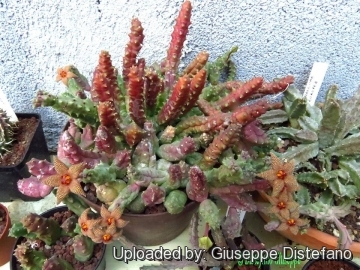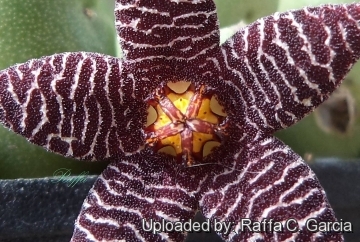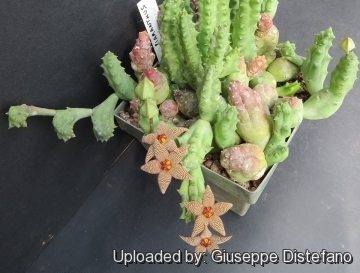Accepted Scientific Name: Piaranthus geminatus (Masson) N.E.Br.
J. Linn. Soc., Bot. 17: 163. 1878 [1880 publ. 1878]

Piaranthus barrydalensis Photo by: Giuseppe Distefano
Origin and Habitat: Barrydale, Little Karo, Western Cape Province, Republic of South Africa.
Synonyms:
See all synonyms of Piaranthus geminatus
Description: As the name implies this species comes from around the town of Barrydale in the Little Karoo region of the Western Cape Province. It is closely allied to the Piaranthus geminatusSN|18039]]SN|18024]]/Piaranthus foetidusSN|18024]]SN|18039]] complex.
Habit: Clumping and prostrate species that spread over the ground forming large cushions. Vegetatively Piaranthus is indistinguishable from Duvalia when not in flower. This is due to their having the same habitat preferences, both being mat forming under host plants.
Stems: Procumbent or ascending, divided in short cylindrical articles 4-angled, with 2-4 minute teeth along each angle. Surface smooth or slightly rough, light-green tips faintly purple.
Flowers: 1 to 3 (rarely more) in a short inflorescence.
Flowers: 13-42 mm in diameter, star-shaped, more or less pubescent, and velvety the colour of the open corolla varying from whitish to yellowish with brown-red dots or transverse lines margin recurved. Corona yellow, and red. Tube absent. Peduncles 2-20 mm long x 1-2 mm in diameter, sepals 2-4 mm long.
Blooming season: Produces numerous flowers simultaneously in October.
Taxonomy remarks: The genus Piaranthus is a very confusing complex of extremely nearly related species with many intermediary forms growing together in many widespread localities and they are very difficult to distinguish. Also experienced botanist found difficulty to separate and classify reliably the various species and forms.
Subspecies, varieties, forms and cultivars of plants belonging to the Piaranthus geminatus group
 Piaranthus barrydalensis Meve: flowers whitish to yellowish with brown-red dots or transverse lines margin recurved. Corona yellow, and red. Distribution: Barrydale in the Little Karoo
Piaranthus barrydalensis Meve: flowers whitish to yellowish with brown-red dots or transverse lines margin recurved. Corona yellow, and red. Distribution: Barrydale in the Little Karoo Piaranthus disparilis N.E.Br.: has smaller corolla-lobes and different markings on the corolla. The crest of the corona-lobes is distinctly toothed, not merely minutely tuberculate. Distribution: Cape Province (Central region Laingsburg Div.)
Piaranthus disparilis N.E.Br.: has smaller corolla-lobes and different markings on the corolla. The crest of the corona-lobes is distinctly toothed, not merely minutely tuberculate. Distribution: Cape Province (Central region Laingsburg Div.)  Piaranthus geminatus (Masson) N.E.Br.: Flowers 13-42 mm in diameter, star-shaped, more or less pubescent, whitish, yellowish, reddish or bright brown, with or without brown-red dots or transverse lines. Corona yellow, unspotted.
Piaranthus geminatus (Masson) N.E.Br.: Flowers 13-42 mm in diameter, star-shaped, more or less pubescent, whitish, yellowish, reddish or bright brown, with or without brown-red dots or transverse lines. Corona yellow, unspotted.  Piaranthus geminatus subs. decorus (Masson) Bruyns: flowers green-yellow with dark red-brown, patches or bands and densely velvety-hairy. inner corona lobes incumbent on the anthers with large and deeply furrowed crests. Distribution: Northern Cape, Western Cape.
Piaranthus geminatus subs. decorus (Masson) Bruyns: flowers green-yellow with dark red-brown, patches or bands and densely velvety-hairy. inner corona lobes incumbent on the anthers with large and deeply furrowed crests. Distribution: Northern Cape, Western Cape. Piaranthus geminatus var. foetidus (N.E.Br.) Meve: Flowers 18 mm to 30 mm in diameter, star-shaped, pubescent, and velvety ivory, to sand coloured, with brown-red dots or transverse lines. Corona yellow to orange.
Piaranthus geminatus var. foetidus (N.E.Br.) Meve: Flowers 18 mm to 30 mm in diameter, star-shaped, pubescent, and velvety ivory, to sand coloured, with brown-red dots or transverse lines. Corona yellow to orange. Piaranthus globosus A.C.White & B.Sloane: The name is due to the stem segments that are ovoid or globose, light green and resemble a mass of tiny potatoes.
Piaranthus globosus A.C.White & B.Sloane: The name is due to the stem segments that are ovoid or globose, light green and resemble a mass of tiny potatoes. Piaranthus pillansii N.E.Br.: flowers 3-4 cm wide, typically greenish yellow, pale yellow or very pale-reddish, without (or with very fine) red spots. Corona yellowish-green.
Piaranthus pillansii N.E.Br.: flowers 3-4 cm wide, typically greenish yellow, pale yellow or very pale-reddish, without (or with very fine) red spots. Corona yellowish-green.- Piaranthus pillansii var. fuscatus N.E.Br.: lobes broad, lanceolate, acuminate, dark purple (or dark crimson?) with very numerous slender irregular transverse and labyrinthine greenish-yellow lines and markings.
- Piaranthus pillansii var. incostans N.E.Br.: lobes densely dotted or transversely marked with light purple on an ochreous ground, sometimes so minutely as to look light pinkish-brown.
Bibliography: Major references and further lectures:
1) Sadly Chris Moore "Piaranthus R.Brown“ 27th May 2009 <http://www.asclepiad-exhibition.org/Notes_Philibertia-Piaranthus_b-g.htm> Web. 3 Dec. 2014.
2) Hermann Jacobsen “A handbook of succulent plants: descriptions, synonyms, and cultural details for succulents other than Cactaceae” Volume 1 Blandford Press, 1960
3) James Cullen, Sabina G. Knees, H. Suzanne Cubey “The European Garden Flora Flowering Plants: A Manual for the Identification of Plants Cultivated in Europe, Both Out-of-Doors and Under Glass” Cambridge University Press, 11/ago/2011
4) Doreen Court “Succulent Flora of Southern Africa” CRC Press, 01/giu/2000
8) Focke Albers, Ulrich Meve "Illustrated Handbook of Succulent Plants: Asclepiadaceae: Asclepiadaceae," Volume 4 Springer, 2002
9) Alain Campbell White, Boyd L. Sloane "The Stapelieae: an introduction to the study of this tribe of Asclepiadaceae" S. E. Haselton, printer, 1933
10) John Robert Brown "Unusual Plants: 110 Spectacular Photographs of Succulents" Abbey Garden Press, 1954
11) Werner Rauh “The Wonderful World of Succulents: Cultivation and Description of Selected Succulent Plants Other Than Cacti” Smithsonian Institution Press, 1984
 Piaranthus barrydalensis Photo by: Giuseppe Distefano
Piaranthus barrydalensis Photo by: Giuseppe Distefano Piaranthus barrydalensis Photo by: Raffa C. Garcia
Piaranthus barrydalensis Photo by: Raffa C. Garcia Piaranthus barrydalensis Photo by: Giuseppe Distefano
Piaranthus barrydalensis Photo by: Giuseppe DistefanoSend a photo of this plant.The gallery now contains thousands of pictures, however it is possible to do even more. We are, of course, seeking photos of species not yet shown in the gallery but not only that, we are also looking for better pictures than those already present.
Read More... Cultivation and Propagation: It is an easy blooming plant when mature that require moderately watering through the growing season but enjoy plenty of water and some fertiliser in hot weather, this helps them to flower freely. Water more sparingly in winter according to temperatures. But, as with most asclepiads, it is unwise to leave them wet in cold weather. Winter care presents no problems at 5°C with plenty of light. Since roots are quite shallow, use a cactus mix or add extra perlite or pumice to regular soil potting soil. A gritty, very free-draining compost is suitable, and clay pots help the plants to dry out between watering.
Sun Exposure: Partial sun or light shade
Pest and diseases: Stapelia species vary in their susceptibility to rotting, but are generally fairly easy to grow, especially if kept pest-free. They are very susceptible to stem and root mealy bugs, and damage from these may well initiate fungal attack. If you do have problems with a stem or with basal rotting, you can reliably isolate the healthy parts, dry them off, and re-root them in moist compost.
Cultural Practices: Re-pot every 2 years
Propagation: Easiest with stem cuttings. Allow cuttings to dry a day before planting. Stems must be laid (Not buried) on gritty compost and will then root from the underside of the stems. It can also be increased from seeds sowing in spring in moist, sandy peat moss.
Potting medium: Since roots are quite shallow, use a cactus mix or add extra perlite or pumice to regular soil potting soil. A gritty, very free-draining compost is suitable, and clay pots help the plants to dry out between watering.













